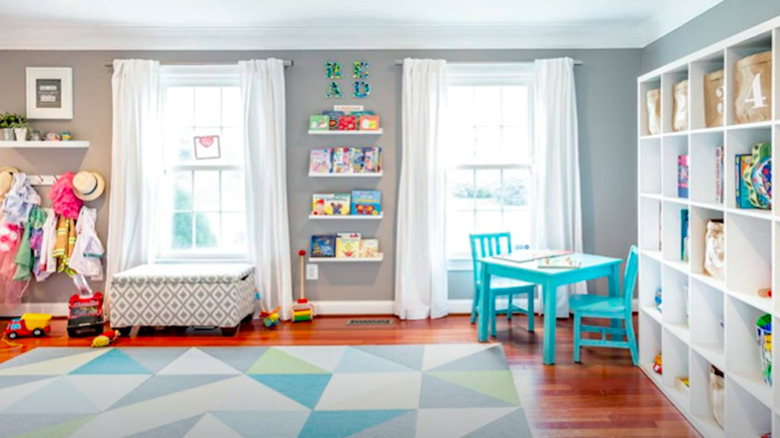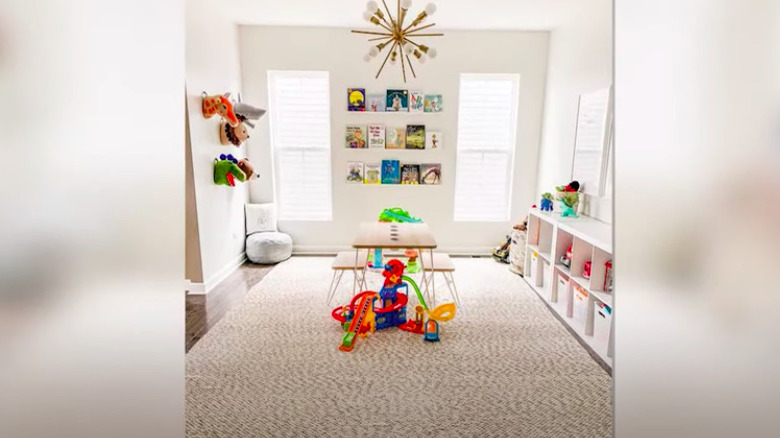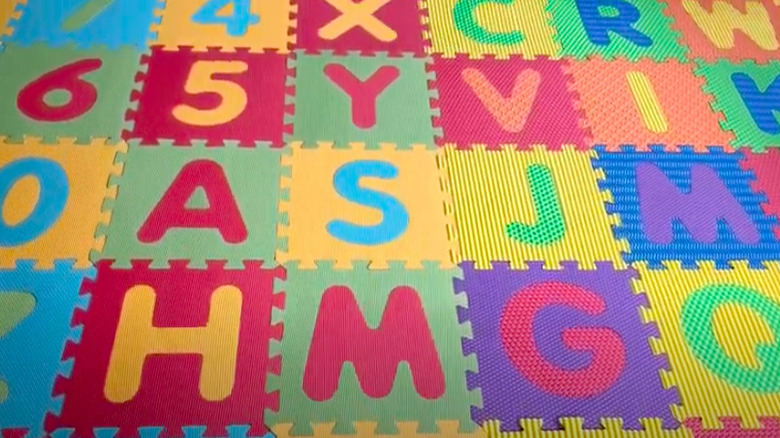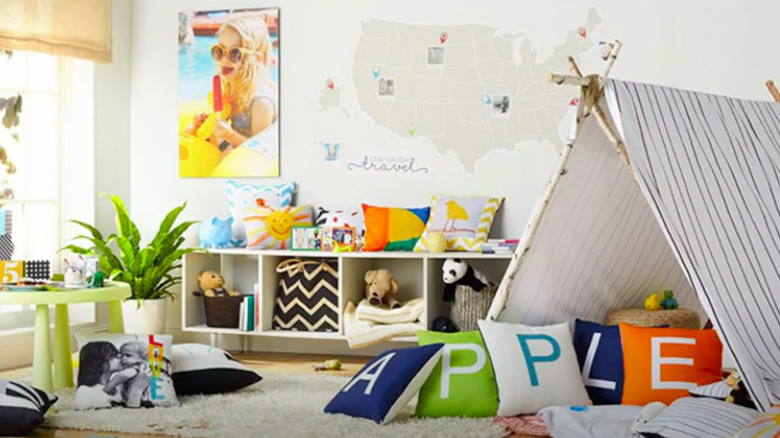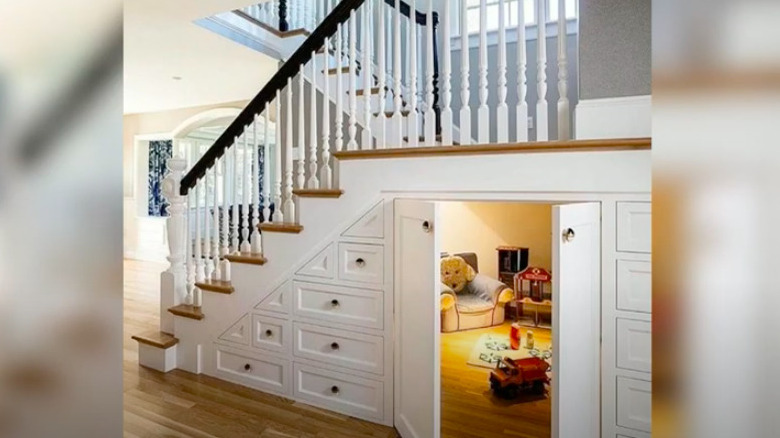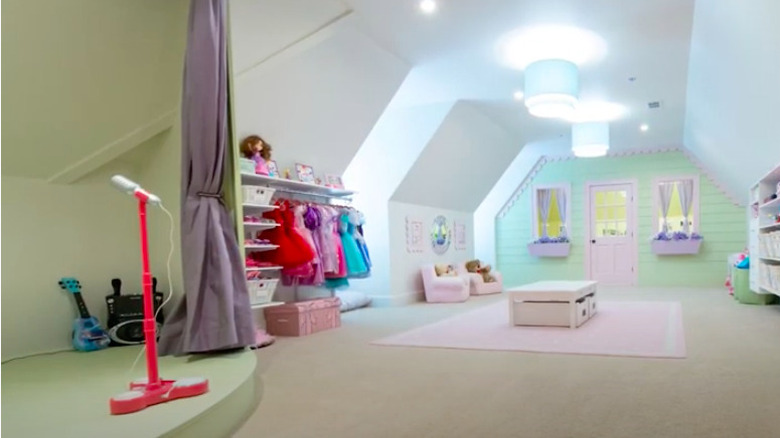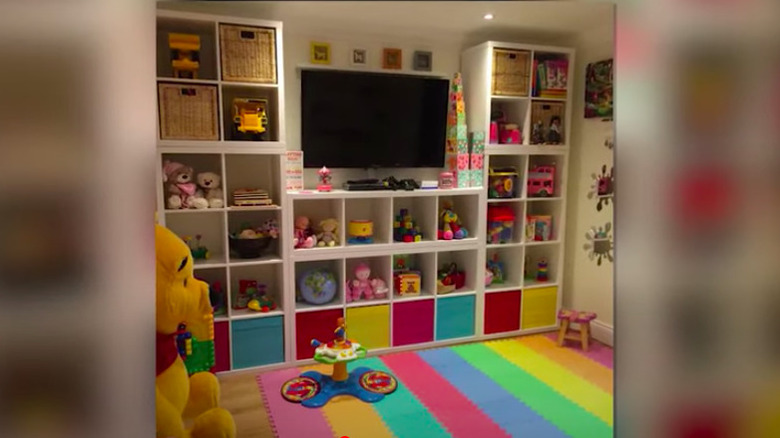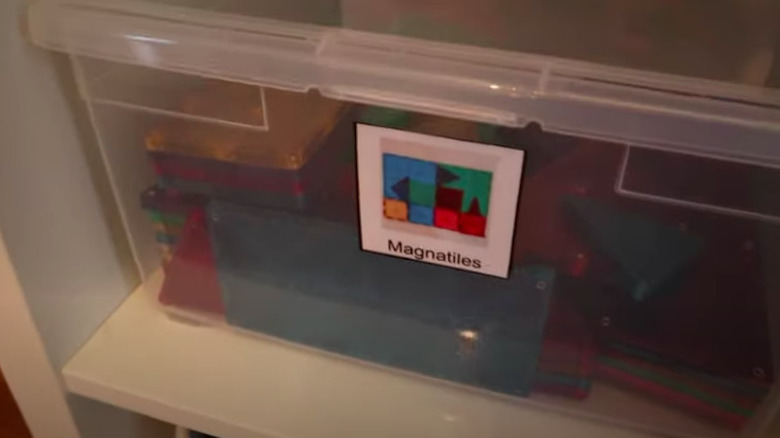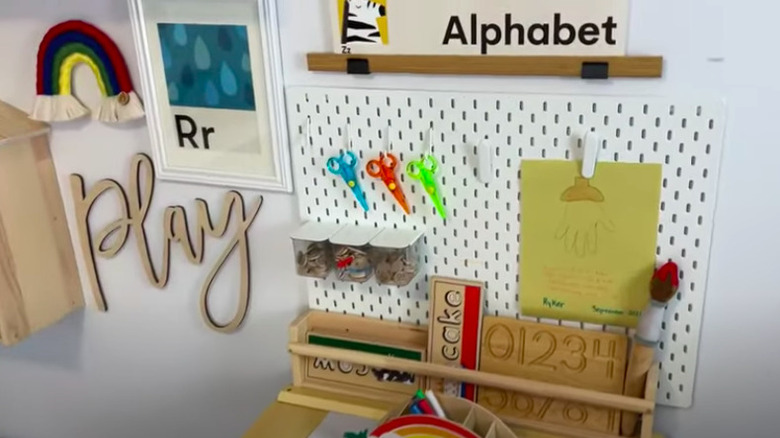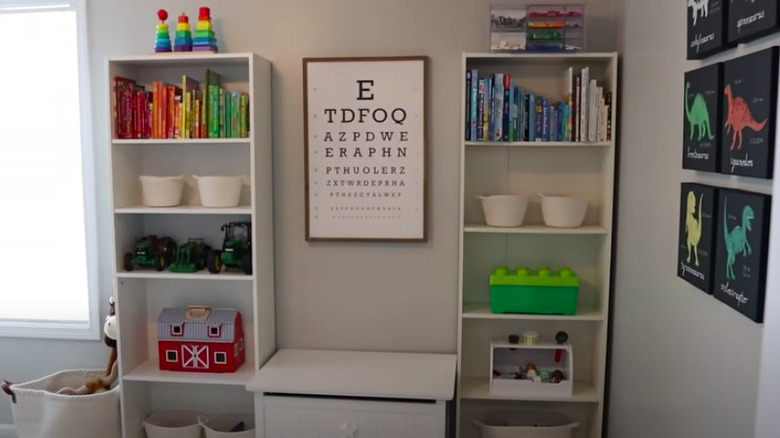45 Playroom Ideas That Will Make Other Parents Envious
Playrooms are often home spaces that don't get the attention they deserve. When toys clutter up, and only the kids step foot in the room, it's easy to wonder what the point is in organizing and decorating it only to have it once again become messy and underappreciated. But, it turns out, children are more likely to learn and grow in an environment where thought has gone into it.
According to Hudson Valley Parent, kids will gain independence and stretch their creative muscles in a space that sets them up for success. Examples include carving out specific zones for them to read, craft, or dress up, placing things at their level to grab and put away, and incorporating physical activity to increase their strength and flexibility. Not only is creating function and flow in the room helpful to your little ones, but adding décor and color can also brighten their moods or even calm them, per The Spruce. Ahead, you'll find 45 ideas to optimize your child's play space for them and their friends.
1. Create a theme
Many new parents decorate their newborn's nursery with a distinct theme. So why not keep up the fun and have one in the playroom they'll soon be using? Safari, outer space and unicorn themes can grow with your child. But if you want to ensure the décor lasts longer than their interests, stick to the basics, such as a classic black and white motif.
2. Infuse bright colors
A colorful space is a fun space. Bring bright colors into the playroom through area rugs, artwork, containers, and seating. In addition to décor, it can also serve to help kids as they learn their colors.
3. Paint the rainbow
Rainbow décor is timeless and can also teach your little ones the colors. Paint a rainbow onto the playroom wall using either primary colors, pastels, or a muted boho style.
4. Draw on the walls
Every parent dreads the moment when they realize their kids were being too quiet because they were busy drawing on the walls. So give them something else to draw on in the form of a chalk wall by installing a classroom-style board or using specific paint on a wall and let them get creative.
5. Magnetize the wall
Rather than those letter and number magnets cluttering up your fridge, give the kids a spot to stick them in the playroom by using a board or magnetic paint. As a bonus, magnets can hold their artwork or learning materials.
6. Stick-on decals
Decals are not only renter-friendly, they also are inexpensive and easy to remove if you want to change around the room or the kids' interests change. Stick on sayings, designs, or their favorite cartoon characters at the moment for quick décor.
7. Travel the globe
A large world map can give kids a global perspective and inspire them to want to travel. Include some animals to teach them about their origin or make it interactive and let them pin where they want to go.
8. Display artwork
Rather than generic artwork in a playroom, use the opportunity to display your child's designs. Frame them and create a gallery wall to let their creativity and pride shine.
9. Create a craft station
What better place to create masterpieces than in a dedicated craft corner of the playroom? Set up a studio space with everything kids need to bring out their inner artists.
10. Set up a study section
While it sounds counterintuitive to do work in a room designated for play, consider adding an area for homework, especially if your home lacks space. It may even motivate kids to focus so that they can get to their toys faster.
11. Stack some books
Whether for fun or school, a designated spot for books is essential in any playroom. Make use of vertical space by installing wall-mounted bookshelves to display their favorite stories.
12. Give room to read
Give kids a comfortable place to read by creating a book nook. Include cozy seating, pillows, and even a canopy to let them get lost in stories.
13. Make a media room
Are your kids big movie buffs or gamers? Dedicate a zone in the playroom as a mini media room so they can watch or play to their heart's content.
14. Make seating comfy
No matter what activity they choose to partake in, kids should have comfortable seating. Bean bag chairs, window seat cushions, and ottoman poufs are the perfect height for them to relax and play.
15. Bring in some trends
Currently, minimalist, or Montessori, and boho-inspired themes are trending in many playrooms. Whatever your style is, consider bringing in some aspects of the trend, such as a neutral play kitchen, wooden toys, and egg chairs.
16. Get swinging
Incorporating swings into a playroom is the ultimate solution for rainy or snowy weather. Consider traditional swings, hanging rattan chairs, or fabric hammocks, depending on your child and the space.
17. Surprise with a slide
It's hard to imagine any kid being unimpressed with an indoor slide. One that extends from a loft gives more room to play and space to store toys.
18. Rock a cool wall
An indoor rock-climbing wall is another impressive feature to add to your child's playroom. Not only is it fun for them, but it can also help improve their flexibility, gain confidence, and learn problem-solving skills.
19. Make it easy to tumble
Of course, safety is important when it comes to climbing walls or sliding. So be sure to have tumbling mats handy in the playroom to prevent any accidents.
20. Put in a pit
Ball pits are the pinnacle of fun at children's parties, so bring the activity into the playroom. An alternative is a foam pit that can be stationed below a rock wall to break any falls.
21. Construct an obstacle course
For really active kids, create a full obstacle course with monkey bars, rope ties, and tunnels in the playroom and watch them stay occupied for the entire afternoon.
22. Hop to it
Use an empty space on the floor of the room to let kids play the classic game of hopscotch. Laying decals is one option; however, foam tiles or a hopscotch rug make it easy to maneuver the game to wherever you need.
23. Lay interactive flooring
Foam tiles are a great way to absorb any falls in a playroom, especially for the really little ones. Make them do double duty and increase their educational skills by putting down ones with letters, numbers, or even animals that help them learn.
24. Build a fort
There's something about building forts that brings out creativity and imagination for kids. Encourage them to construct different designs using cushions specifically shaped and made for fort building.
25. Pitch a tent
When the weather doesn't allow for a campout in the backyard, let the kids enjoy one in the playroom. Pitching a tent allows them to hide away, snuggle up, or quietly read without being disturbed.
26. Put together a teepee
Teepees are known to specifically help smaller children physically develop as it requires them to crawl in and out. In addition, placing toys inside, such as building blocks or stuffed animals, encourages them to play while also keeping some of the clutter hidden.
27. Build a treehouse
For older children, the thought of a treehouse as a sort of escape is exciting. Give them their own indoor one to be able to climb and play with their friends, no matter what season it is.
28. Take advantage of stairs
Are you too limited on space to have a separate playroom? Create a cozy one underneath the stairs that kids will love to hide away in.
29. Make a music stage
For the musically inclined child, a space dedicated to signing or playing instruments would be a dream come true. Make a mini stage with a microphone, guitars, and drums to let them embrace their rockstar style.
30. Design a dress-up corner
Playing dress-up is a rite of passage for all children. Set up a dressing station with all of their costumes, shoes, and accessories to play pretend and keep everything organized.
31. Visit the zoo
All kids love stuffed animals, but it's no secret that they can take up a lot of space. So contain them into a cage when they're not being played with to prevent them from cluttering up the playroom.
32. Go wild with animals
Perhaps you want to decorate the playroom by scattering large-sized animals, especially if it's safari-themed. This can spark your child's imagination and inspire them to want to learn more about wildlife.
33. Park some trucks
Toy trucks tend to take up a lot of space, especially when there's a large quantity in the playroom. Give them a specific parking spot, whether in a cubby or using decals to create a mini lot, and encourage your kids to return them when they're done playing.
34. Embrace built-ins
Built-in shelves and bookcases are a great way to maximize storage in a playroom. Use them to store new toys that are waiting to be rotated into the rest or to display memorabilia and sentimental items for your little one.
35. Depend on cubbies
Cube units are ideal for growing children and also to hide visual clutter in playrooms. Start small, and then add on as the amount of stuff grows if need be. Use cube-shaped bins to tuck away small toys and open shelving to display larger ones.
36. Aim for eye level
Ideally, children should be able to reach for their toys themselves, so place containers at their eye levels. This will also help to encourage them to partake in cleanup since it'll be easier for them to put things away.
37. Label using photos
Labeling bins and baskets is crucial to let your child know where things are and where to return them. If they're in their early learning stages, consider adding photos in addition to the words to teach them meanings and make this process easier on them.
38. Let furniture serve double duty
If your playroom is on the small side, it's especially important to maximize the space by using furniture that serves double duty. Bean bag chairs that store stuffed animals and a desk with a spot for baskets underneath are genius ideas to utilize the space as much as possible.
39. Utilize a pegboard
Usually found holding tools in a garage, pegboards can be helpful organizers in a playroom too. Use them to store art supplies such as scissors or hanging cups with markers and crayons to save space on a craft table.
40. Don't forget décor
There's nothing inviting about a bland playroom. Give your child visual stimulation and boost their mood with fun and stylish décor. Include artwork (theirs or store-bought), plants, and patterned wallpaper to brighten up the space.
41. Hang whimsical lighting
There's nothing holding you back from having a little fun with lighting in the playroom. Hang marquee letters, neon signs, or cloud lamps and watch as your kid's eyes light up with them.
42. Have a long-term vision
Kids tend to grow up before our eyes, so having a long-term vision for the playroom is important when designing it. Use quality furniture that can withstand the test of time and be versatile, such as a bookcase that can hold toys and trophies later.
43. Divide it into two
If a completely separate playroom isn't possible for your home's layout, divide a room into a kid-friendly and adult-appropriate space. Make one half into a lounge area for parents to hang out in, play pool, or watch their shows and the other into a playroom for kids' craft, play, or build.
44. Track their growth
Children love to see how tall they're getting, so implement a growth chart into the playroom using a DIY method, a premade sign, or wall decals.
45. Leave space for a nap
After all of the action in their playroom, kids will most likely be going to need a nap to regain energy. So carve out a small area for them to get some shut-eye before moving on to the next activity.
